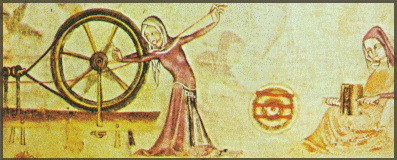
In the Middle Ages, most things were made in small workshops by craftsmen or women with a few helpers, or by people working at home. A woman might spin wool, or her husband make shoes, in their own cottage. They would sell what they made at the market or perhaps take it to someone who would sell it for them.

Women spinning and carding wool. The spinning wheel came to Europe from India in the 13th Century
As time went on, the population grew. Towns too were growing. Many peasants went to live in towns where they could be free of their feudal lords, and learnt new trades. Many craftsmen from the country also came to the towns where there were more people to buy their wares. There began to be larger workshops, dyeing wool, weaving cloth, making candles etc. Some richer people could now employ lots of others to work for them. They could sell what their workers made and, if they wanted, keep most of the profits for themselves.

Two goldsmiths in their workshop making candlesticks for the church
When Chrétien de Troyes was writing about the silk-workers of Pesme Aventure, this process was just beginning. In Champagne, the part of France where he was living, the silk industry was developing, and women's labour was used to produce beautiful silken cloth for clothes and furnishings. Some rich nobles in the area even kept a workshop full of girls embroidering silken cloth at their courts. Judging from the way Chrétien writes about the suffering of the girls and how they are made to work so hard for so little money, it seems he found this new system rather shocking.